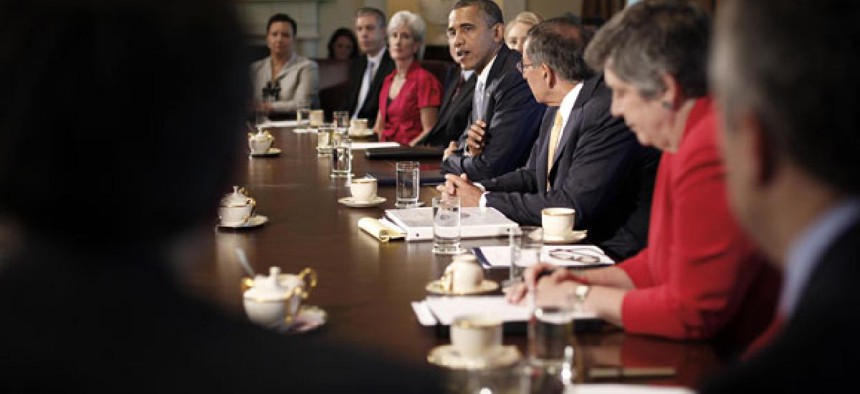Analysis: Don’t be fooled -- this transition matters more than ever
Second-term leadership changes are pivotal as agencies face fiscal pressure.
President Obama’s reelection means there is not a presidential transition in the usual sense of the word. Compared with four years ago, there will be no building a staff from scratch, learning the ropes of working in the White House and federal agencies, or navigating a wholesale hand-off of power from an outgoing president. Under the radar, however, there is still a transition happening and, because of its timing, these 75 days between the election and inauguration are as important as ever.
After four exhausting years, many high-profile appointees among Obama’s first-term cadre of Cabinet secretaries and White House aides are leaving. But in quieter fashion, there also is an exodus of sub-Cabinet officials from dozens of large, complex agencies. Beneath the surface -- away from the cable television chatter and front page headlines -- these assistant secretaries or deputy administrators are the people who, in partnership with senior career leaders, actually run the federal government day-to-day. And, contrary to the general view that this is a placid moment, the transition under way for these positions matters more than ever.
This transition occurs not during a quiet post-election lull, but in the midst of the fierce and fundamental debates over government spending surrounding the so-called fiscal cliff. These budget pressures mean change is unavoidable for federal agencies. Agency leaders -- newly appointed and continuing alike -- must choose between being buffeted by today’s budgetary events and taking proactive steps now that not only save money but also improve performance. We are entering an era of more for less, and the people actually running the federal government are going to face new demands and tensions that require new approaches.
The good news is during the president’s first term many agencies established a solid foundation. Successful examples in areas such as customer service and permit processing have led to clear roadmaps and proven tools for senior managers across the government. The bad news, however, is under any near-term budget deal scenario, the cuts to agencies will be significant, the effects often immediate. Simply put, agency leaders must find ways to do better with less and the current fiscal pressure cooker means they must take action quickly.
The sub-Cabinet team has a critical role to play in meeting the challenge. Three principles can help them accomplish the goal:
- 1. Don’t just spread the pain, even though this can seem like a fair way to deal with tighter budgets. Instead, seek out the bigger changes required to make government work more effectively, at lower cost and at higher levels of service. A far-reaching idea, for example, is Obama’s proposal for a restructured Cabinet department that would consolidate the Commerce Department, Small Business Administration, the Office of the U.S. Trade Representative, and other agencies. Other ideas are more ground-level, but with comparable impact. For instance, after a natural disaster, the federal government often creates one point of contact for those seeking assistance. Why not replace the fragmented, duplicative day-to-day federal operations in many U.S. cities with a similar single point of presence? Such streamlining could reduce costs and simplify service delivery to citizens.
- 2. Use technology and data to allocate scarce resources where they can have the greatest impact. Agencies run many indispensable oversight and inspection functions, for example. But in recent years, developments such as financial fraud and environmental disasters have reminded us that as the world grows more complex and fast-changing, government agencies have finite resources and cannot monitor everything at all times. Using historic and real-time data, agencies can direct scarce resources to the areas of greatest risk, substantially improving outcomes while often reducing costs.
- 3. Demonstrate change leadership, not just change management. Agencies must improve how work gets done, day to day, in the trenches. Top leaders cannot expect simply to direct a new approach and count on it to work, no matter how well-conceived in theory. Instead, the human dimension -- energized, engaged leadership working jointly with staff at all levels -- is essential. Most federal employees are mission-driven, which means that if they can’t readily see the link between a set of changes and their agency’s fundamental objectives, their support erodes. By contrast, when leaders and employees alike are involved and hold each other mutually accountable, results follow.
The debate over our fiscal future so often gets simplified to one about cuts and revenue, dollars and cents. The challenge for agency leaders and front-line staff alike is to use this moment to drive performance improvement and change the way the work of government gets done. Employees at all levels understand that change is coming at every agency as an era of more for less takes hold. The task for new leaders coming into their jobs -- and those staying on -- is to find ways to be the architects, not the prisoners, of that change. That is an immense responsibility, but one that will define the future of their departments and the federal government for years to come.
Vivian Riefberg is leader of the public sector practice in the Americas at McKinsey & Co. Jon Wilkins is a director at McKinsey & Co. and was a member of the Obama-Biden 2008 transition team.
NEXT STORY: Are Government Workers Learning Anything?



